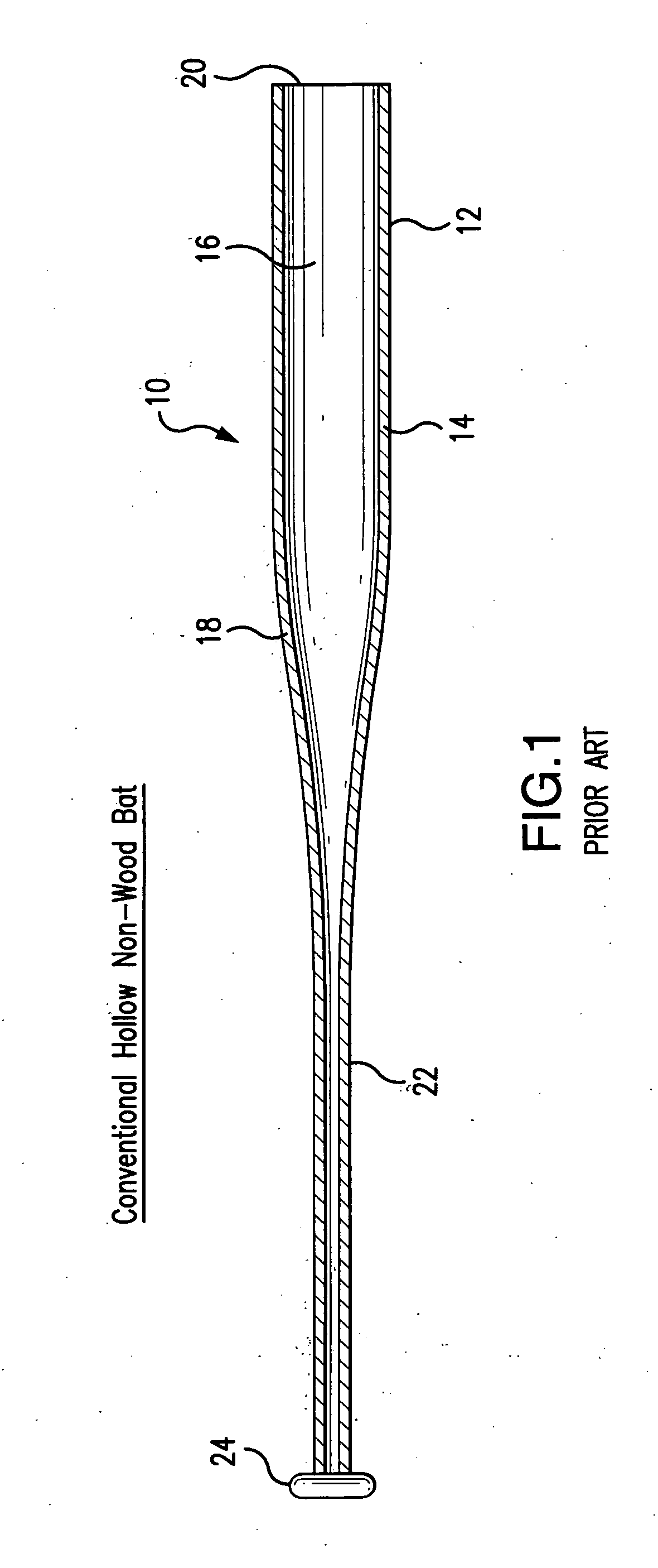Baseball bat employing a dual density foam material
a dual-density foam and bat frame technology, applied in the field of baseball bats and softball, can solve the problems of reducing the responsiveness of the bat, affecting compromising the hitting performance of less skilled players, so as to reduce the vibration, dampen even small deflections of the baseball bat frame, and increase the barrel response
- Summary
- Abstract
- Description
- Claims
- Application Information
AI Technical Summary
Benefits of technology
Problems solved by technology
Method used
Image
Examples
first embodiment
[0023]FIGS. 3 and 4 illustrate the present invention. These figures show a non-wood bat 42 including a barrel section 44 provided with an outer surface 46, an end cap 50, a handle 52 and a tapered section 48 extending between the barrel 44 and the handle 52. Similar to prior art bats, an end knob 54 would be provided at the end of the handle section 52. The entire interior section of the barrel 44 would be filled with two different types of foam material. The majority of the interior section of the barrel 44 would be filled with a relatively low compression inner foam material 58. The tapered portion 48 and the handle portion 52 are not filled with the foam material and remain hollow for their entire length as shown by 60.
[0024]This inner foam material 58 would be surrounded by a thin highly compressible outer foam layer 56. The outer highly compressible foam layer 56 could be constructed from an open cell polyether or polyester foam having a compressive deflection of less than one ...
second embodiment
[0025]FIG. 5 illustrates the present invention which primarily illustrates the barrel portion 62 having an outer surface 64 of the bats illustrated with respect to FIGS. 3 and 4. Similar to FIGS. 3 and 4, the portion of the bat illustrated with respect to FIG. 5 would include a relatively low compressibility foam layer 68 surrounded by a relatively high compressibility layer 66. However, as illustrated with respect to FIGS. 3 and 4, the thickness of the outer foam layer 58 and the outer foam layer 56 is constant over the length of the barrel 44. This is to be distinguished from the barrel 62 in which the thickness of the outer foam portion 66 and the inner foam portion 68 would gradually vary over the length of the barrel 62. For example, the thickness of the outer foam layer 66 is smallest at approximately the middle portion of the bat 72. The diameter of the outer foam layer 66 would gradually increase as it moves from the section 72 to section 70 as it approaches the end cap of t...
PUM
 Login to View More
Login to View More Abstract
Description
Claims
Application Information
 Login to View More
Login to View More - R&D
- Intellectual Property
- Life Sciences
- Materials
- Tech Scout
- Unparalleled Data Quality
- Higher Quality Content
- 60% Fewer Hallucinations
Browse by: Latest US Patents, China's latest patents, Technical Efficacy Thesaurus, Application Domain, Technology Topic, Popular Technical Reports.
© 2025 PatSnap. All rights reserved.Legal|Privacy policy|Modern Slavery Act Transparency Statement|Sitemap|About US| Contact US: help@patsnap.com



